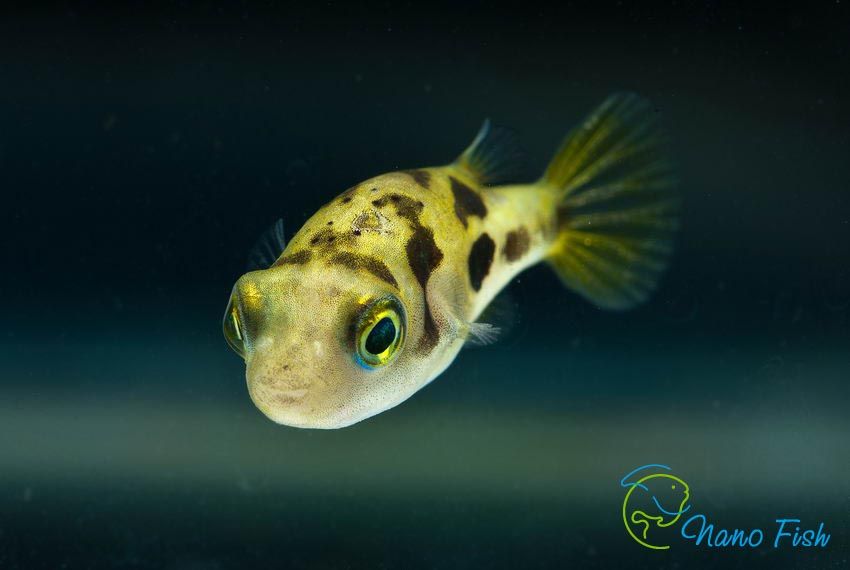
Introduction
he Dwarf Puffer in many ways can be called the ideal puffer for most aquarists. The Dwarf Puffer lives in freshwater, originating from inland India. The most convenient aspect of these fish is that they are very small, only getting an inch long, and thus one can be kept in a 5 gallon tank, unlike most other puffers which require much larger aquariums. They also have an advantage in the eyes of many aquarists in that there is one fish that is pretty much guaranteed to work with them: otos. Dwarves seem to leave otos alone and let them do their job, unlike most other fish which they pester and nip. Sometimes you can keep larger shrimp with the Dwarf Puffer, but sometimes they'll end up as a snack. It's basically a gamble with shrimp. There are very limited amounts of success keeping these puffers with other fish. Most fish are either too large and can swallow the puffers whole, and the rest will likely be nipped quite a bit and harassed.
Dwarf puffers get bored easily. A good tank setup for them is five gallons per puffer, sand substrate, heavily planted, and more hiding places than puffers. When kept in groups this is particularly important as they can be quite territorial. It's also recommended to keep a ratio of 1 male to 2-3 females. Females are generally more round than the males, and, when mature, males have a dark line down the length of their belly and often have iridescent "wrinkles" on their faces. Breeding has occurred in captivity, but it doesn't happen often, and seems to occur without the aquarist doing anything to promote it. This puffer seems to be more prone to shyness than larger puffers like the Green Spotted Puffer and Figure 8 Puffer, probably just due to their small size and likelihood of being preyed upon by larger fish. They will usually eventually come around though, even if it takes several weeks or months, and show that "puffer personality" that is one of the best parts of keeping puffers in my opinion.
These dwarf puffers can be rather picky about their food. Most will accept frozen blood-worms, snails, and live black-worms. Other foods include all kinds of shrimp as well as daphinia As with all puffers, they are very sensitive to water conditions, so 0 ammonia, 0 nitrite, and very low nitrate (preferably below 10ppm, but no more than 20ppm). Careful accumulation is also advised. If you are looking for something exciting, unique, and challenging, the dwarf puffer might be for you!
Pictures
Dwarf Pufer Care:
Scientific Name : Carinotetraodon travancoricus
Common Names : Dwarf puffer, Peewee puffer, Pea puffer, Pygmy puffer, Bumblebee puffer, Indian dwarf puffer, BB puffer, Malabar puffer
Care Level : Easy
Size : 1 inch (3 cm)
pH : 6.5 to 7.5
Temperature :76-82 F (24 - 28°C)
Water Hardness : 5 - 20
Lifespan : probably about 5 years
Origin / Habitat : inland waters of India
Temperament / Behavior : semi-aggressive fin-nippers
Breeding : A relatively small number of spawnings have occurred. Keep a ratio of 2-3 females per male.
Aquarium Size : Provide about 5 gallons per puffer due to their territorial nature.
Dwarf Puffer Tank Mates : Can be kept in groups if adequate space and decor are provided. Do well with otocinclus. Slow moving fish and fish with long, colorful fins will be nipped and/or harassed.
Fish Disease : Be sure to quarantine, as they are often wild caught and often come in with parasites.
Dwarf Puffer Food : Blood-worms, snails, brine shrimp, mysis shrimp, black-worms, daphnia
Tank Region : Middle - they are active swimmers.
Gender : Female Dwarf Puffers are rounder and larger than males. Male Dwarf Puffers have dark line down the length of their bellies when mature, and sometimes have iridescent "wrinkles" on face.
References:
- Aqualog: The Puffers of Fresh and Brackish Waters by Klaus Ebert
- www.dwarfpuffers.com
- Picture Link: (http://www.nanofish.com.ua/images/product_images/popup_images/fish/karlikovyj-tetradon---carinotetraodon-travancoricus_4.jpg)
About the author: See https://plus.google.com/u/0/109694715592258333037
Common Names : Dwarf puffer, Peewee puffer, Pea puffer, Pygmy puffer, Bumblebee puffer, Indian dwarf puffer, BB puffer, Malabar puffer
Care Level : Easy
Size : 1 inch (3 cm)
pH : 6.5 to 7.5
Temperature :76-82 F (24 - 28°C)
Water Hardness : 5 - 20
Lifespan : probably about 5 years
Origin / Habitat : inland waters of India
Temperament / Behavior : semi-aggressive fin-nippers
Breeding : A relatively small number of spawnings have occurred. Keep a ratio of 2-3 females per male.
Aquarium Size : Provide about 5 gallons per puffer due to their territorial nature.
Dwarf Puffer Tank Mates : Can be kept in groups if adequate space and decor are provided. Do well with otocinclus. Slow moving fish and fish with long, colorful fins will be nipped and/or harassed.
Fish Disease : Be sure to quarantine, as they are often wild caught and often come in with parasites.
Dwarf Puffer Food : Blood-worms, snails, brine shrimp, mysis shrimp, black-worms, daphnia
Tank Region : Middle - they are active swimmers.
Gender : Female Dwarf Puffers are rounder and larger than males. Male Dwarf Puffers have dark line down the length of their bellies when mature, and sometimes have iridescent "wrinkles" on face.
References:
- Aqualog: The Puffers of Fresh and Brackish Waters by Klaus Ebert
- www.dwarfpuffers.com
- Picture Link: (http://www.nanofish.com.ua/images/product_images/popup_images/fish/karlikovyj-tetradon---carinotetraodon-travancoricus_4.jpg)
About the author: See https://plus.google.com/u/0/109694715592258333037
